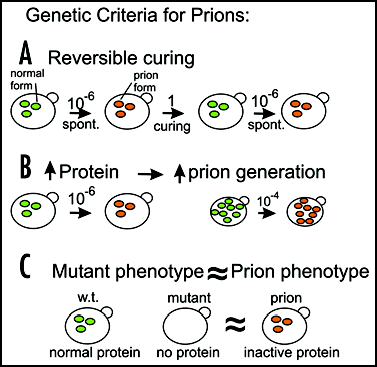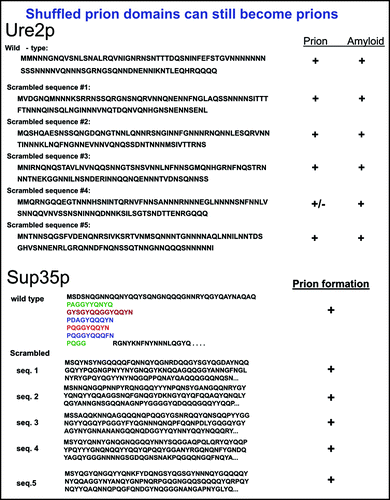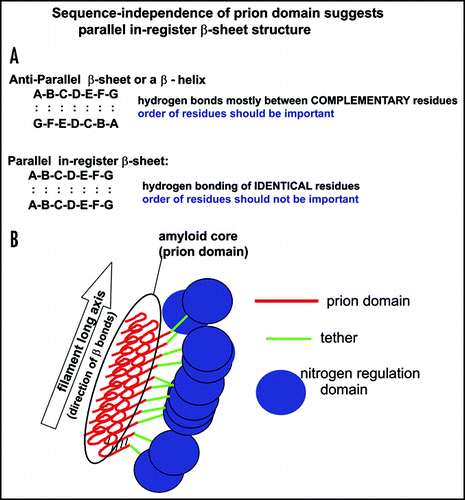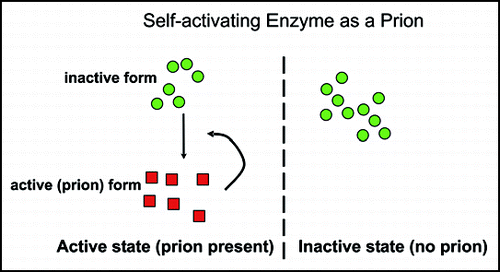Figures & data
Figure 1 Genetic criteria for prions. Reversible curing means that in a strain cured of a nonchromosomal genetic element, the same element can arise again. Overproducing a protein with the potential to become a prion increases the frequency with which the prion arises. If the prion form of the protein is an inactive form of the protein, then the phenotype of the presence of the prion is the same or similar to that of a mutant in the gene for the protein. Each of these three properties should be characteristic of prions but none of them are known (or expected) for nucleic acid replicons such as plasmids or viruses.

Figure 2 Scrambled prion domains can still be prions.Citation34,Citation35 In place of the normal Ure2 or Sup35 prion domains, shuffled prion domains (five of each) with the same amino acid content were constructed and integrated. Each of the shuffled prion domains could be a prion, although one of each was unstable.

Figure 3 A prion domain insensitive to scrambling should be a parallel in-register amyloid.Citation47 (A) Nonidentical residues are bonded in an anti-parallel β-sheet or β-helix. The specificity of amyloid propagation (similar to crystal growth) implies that there must be some complementarity of residues. Shuffling such a sequence would destroy any such complementarity and thus prion formation. Shuffling a parallel in-register β-sheet leaves identical residues paired with each other. If a prion domain can be shuffled and not lose prion-forming ability, it suggests a parallel in-register β-sheet structure. (B) Model of Ure2p amyloid structure (see text).

Figure 4 Amyloid of Ure2p is infectious.Citation56 Amyloid made in vitro from recombinant Ure2p (full length or the prion domain or fusions of the prion domain with other proteins) are infectious for yeast. (A) Filaments are sonicated (bar = 100 nm) and introduced into spheroplasts with a DNA plasmid and polyethylene glycol. (B) A large proportion of the clones transformed for the DNA plasmid were also infected with [URE3]. (C) The infected clones included several prion variants distinguished by stability and intensity of the phenotype, here indicated by activity of a DAL5-promoted ADE2 gene. Red clones have lost [URE3]. Extracts of each variant are infectious and transmit the variant of the strain from which they were made.Citation56
![Figure 4 Amyloid of Ure2p is infectious.Citation56 Amyloid made in vitro from recombinant Ure2p (full length or the prion domain or fusions of the prion domain with other proteins) are infectious for yeast. (A) Filaments are sonicated (bar = 100 nm) and introduced into spheroplasts with a DNA plasmid and polyethylene glycol. (B) A large proportion of the clones transformed for the DNA plasmid were also infected with [URE3]. (C) The infected clones included several prion variants distinguished by stability and intensity of the phenotype, here indicated by activity of a DAL5-promoted ADE2 gene. Red clones have lost [URE3]. Extracts of each variant are infectious and transmit the variant of the strain from which they were made.Citation56](/cms/asset/27c1d923-dd48-4447-84be-83999e492965/kprn_a_10904664_f0004.gif)
Figure 5 Enzymes needed for their own activation can be prions. “Prion” means “infectious protein”, not necessarily amyloid based. If an enzyme is essential for activation of its own precursor, then cells without the active form produce the same as progeny, and those with the active form produce offspring of the same kind. Transmission of just the active form (the protein only) from one cell to another lacking it, transmits the self-propagating activity, and so is an infectious protein. Two such systems have been described, the vacuolar protease B of S. cerevisiae,Citation69 and a protein kinase of Podospora anserina.Citation72

Table 1 Nonchromosomal genetic elements in wild Saccharomyces